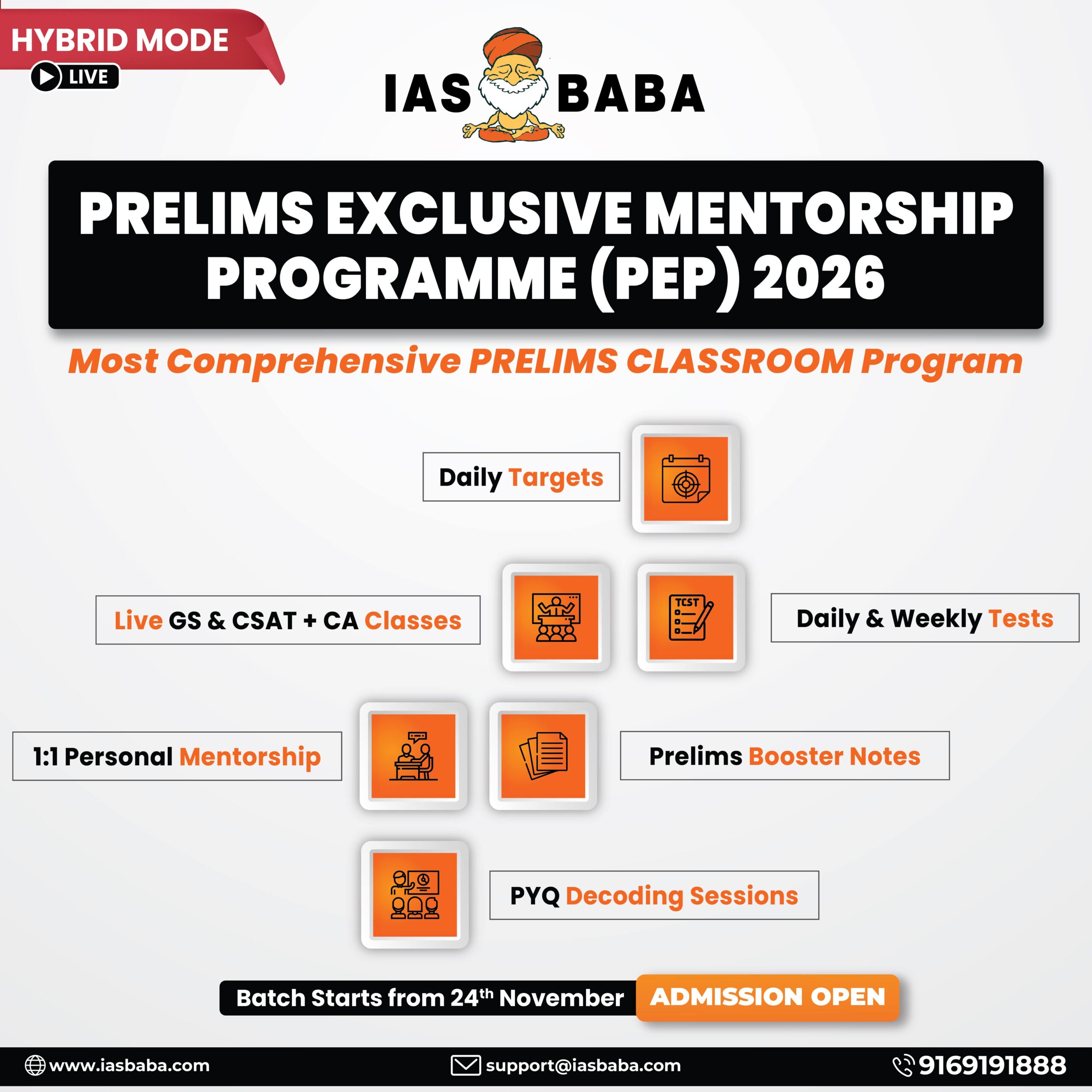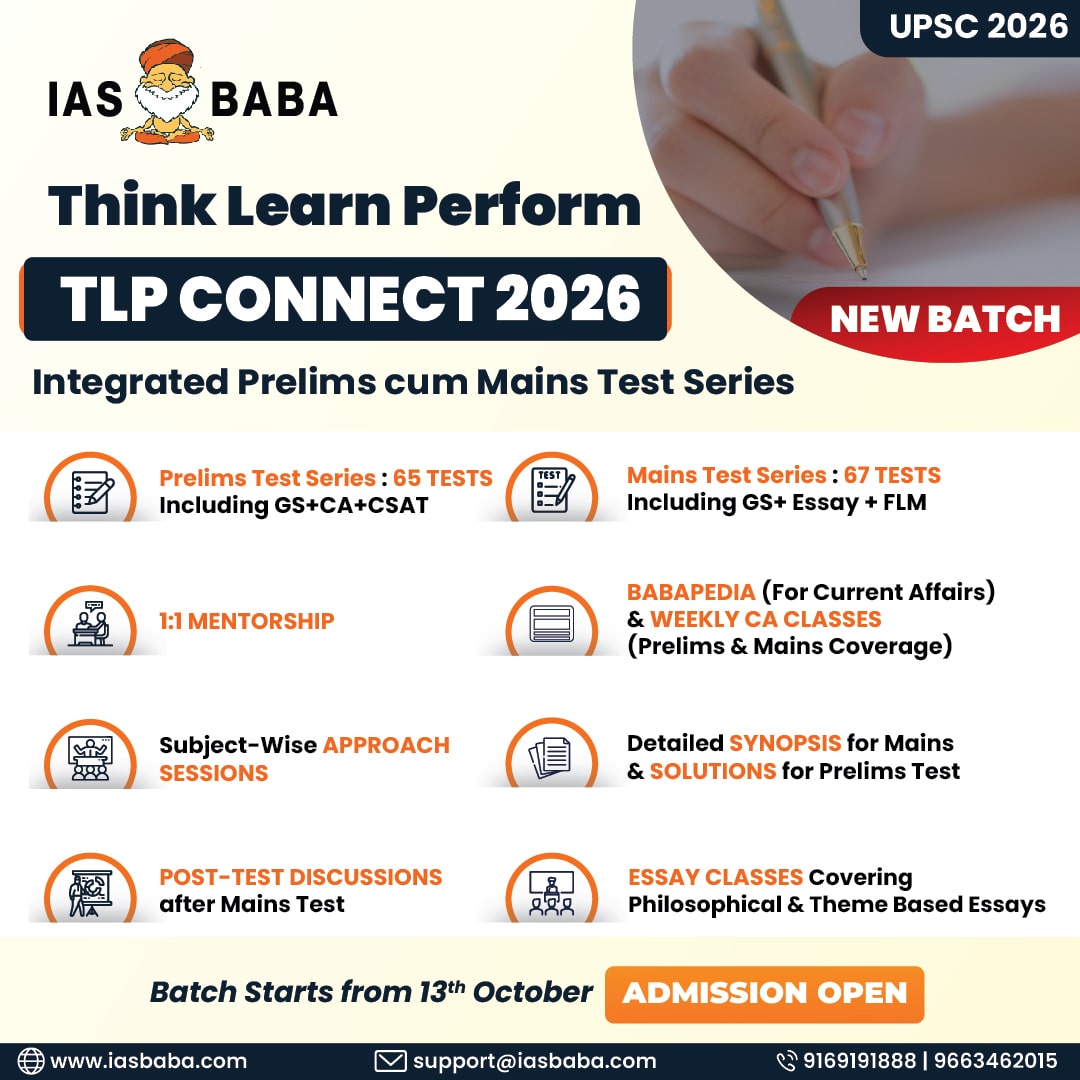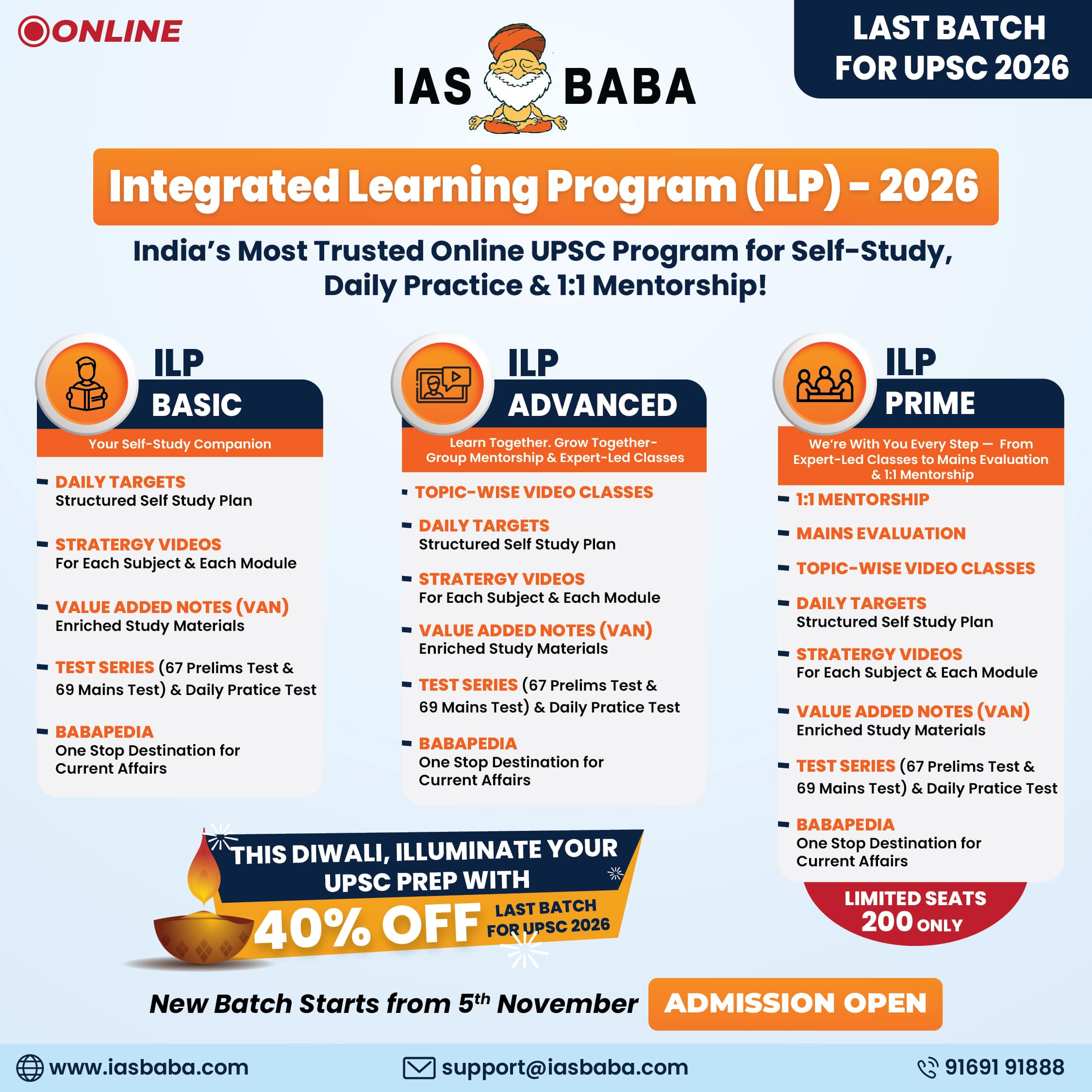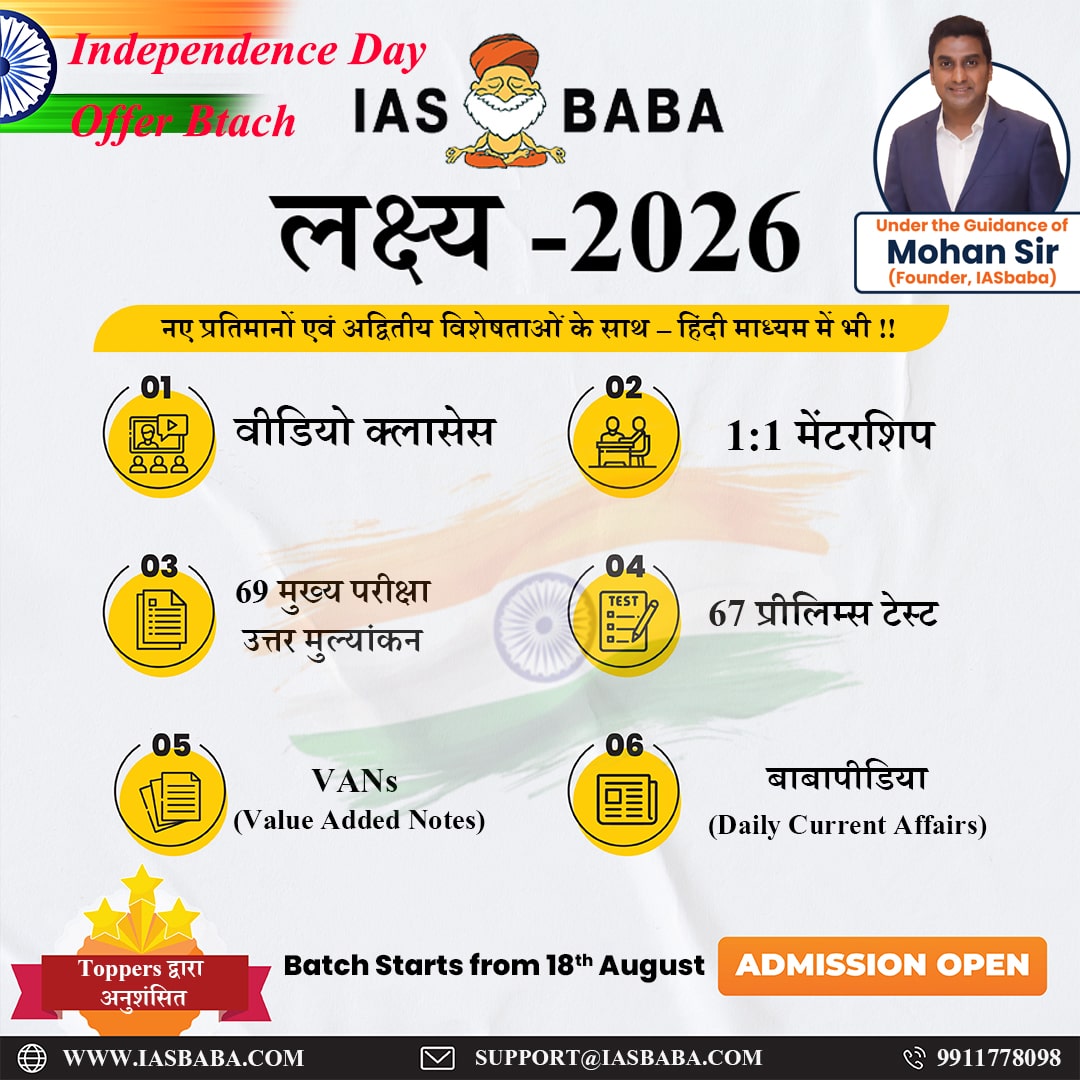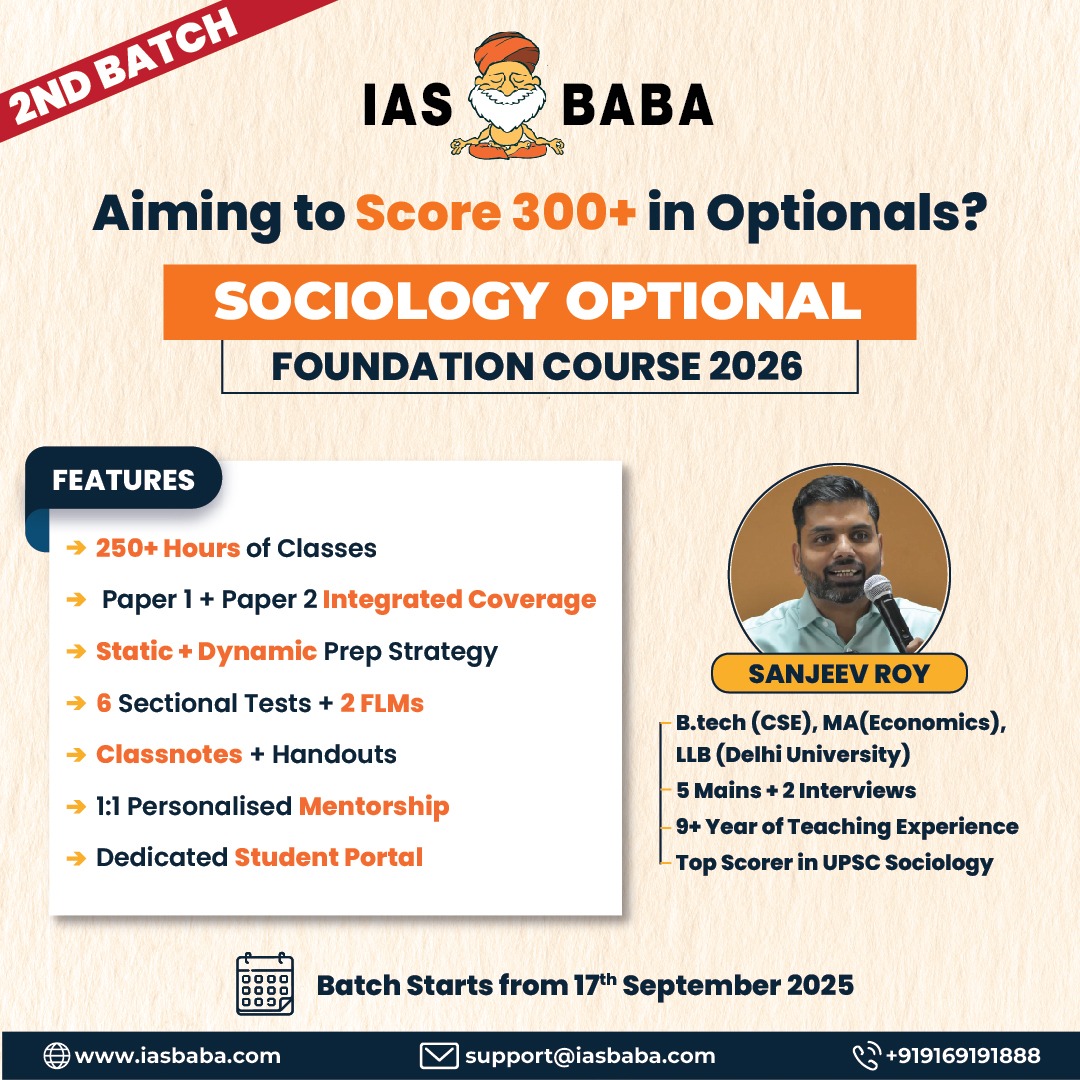IASbaba's Daily Current Affairs Analysis
Archives
(PRELIMS & MAINS Focus)
Syllabus:
GOVERNMENT SCHEMES
Context: The Green Credit Programme (GCP) rolled out by the Ministry of Environment, Forest and Climate Change was flagged by the Ministry of Law and Justice before its rollout, over legality of the business model built into it.
Decoding the context: Prime Minister Narendra Modi and Sheikh Mohammed bin Zayed Al Nahyan, the President of the UAE, officially unveiled the GCP on December 1, 2023, during the annual United Nations climate conference in Dubai. It was dubbed as a mechanism to incentivise “pro-planet” actions in response to climate change, and one which would promote the Centre’s Mission LiFE (Lifestyle for Sustainable Environment).
Learning Corner:
- At its core, the GCP seeks voluntary participation (read investments) of individuals, companies, industries, and other entities across seven different activities — such as tree plantation, waste management, and water conservation — that will lead to improvements in the environment.
- This participation will be incentivised by generating “green credits”, which can then be traded on a domestic market platform to potential buyers looking to meet sustainability targets, or existing legal obligations. For instance, could be exchanged for meeting compliance of compensatory afforestation.
- The credits can also be used by listed companies as part of their environmental, social and governance disclosures under SEBI’s Business Responsibility and Sustainability framework, indicating efforts taken by these companies on environmental sustainability.
How will green credits be calculated?
- Initially piloted for tree plantation and eco-restoration, including soil moisture conservation and rainwater harvesting.
- The Indian Council of Forestry Research and Education (ICFRE), Dehradun, serves as the nodal agency for GCP pilot on tree plantation and eco-restoration.
- Plantations will be carried out in degraded land parcels including open forest, scrubland, wasteland and catchment areas, and they must be five hectares in size or above.
- Forest departments identify land parcels and allocate them to registered entities, with plantations to be completed in two years.
- Green Credit Calculation: 1 grown tree = 1 green credit, subject to a minimum of 1,100 trees per hectare.
Criticism & Concerns
- GCP has been criticised for incentivising forest diversion for industries, by generating tradable credits which could also be used to meet legal obligations such as compensatory afforestation.
- It has also been criticised for promoting plantations on degraded lands, open forests and scrub lands, which experts have argued offer unique and important ecological services.
- Under the Van (Sanrakshan Evam Samvardhan) Adhiniyam, 2023, non-forest land equivalent to forest land used for industries and development projects is mandated for compensatory afforestation. Only if non-forest land is unavailable, twice the size of degraded or unclassed forest land is used for compensatory afforestation.
- However, GCP mandates use of degraded forest land for plantations. It also has complementary provisions which allow exchange of credits, generated by paying money, for meeting the compensatory afforestation compliance. This translates into compensating for older forests with existing forest land, rather than adding non-forest land into the forest cover, as laid down in the Van Adhiniyam.
Source : Indian Express
Syllabus:
INTERNATIONAL
Context: Fiftieth anniversary of the entry into force of Biological Weapons Convention (BWC) was marked recently.
Decoding the context: As the first multilateral disarmament treaty to ban an entire class of weapons of mass destruction, the BWC has played a crucial role in establishing the global norm that the use of disease as a weapon is unacceptable.
Learning Corner:
- The Biological Weapons Convention (BWC) is a landmark international treaty that prohibits the development, production, acquisition, stockpiling, and use of biological and toxin weapons.
- The concept of biological warfare—using disease-causing organisms or toxic substances as weapons—has troubled humanity for centuries. The BWC formally arose from the recognition that biological agents, if weaponized, could lead to devastating epidemics and widespread disruption.
- Negotiated in the shadow of the Cold War, the BWC was opened for signature on April 10, 1972, in ceremonies held in London, Moscow, and Washington, D.C.
- It entered into force on March 26, 1975, after the requisite number of states had ratified the treaty. The negotiations built upon earlier disarmament efforts, notably the 1925 Geneva Protocol, which had prohibited the use—but not the possession or development—of biological weapons.
Key Provisions
- The treaty is relatively concise in its text—even though it addresses an entire class of weapons, it consists of just 15 articles that set out clear prohibitions and obligations. The main provisions include:
- Prohibition on Development and Production: States Parties undertake not to develop, produce, or acquire biological agents or toxins that have no justification for prophylactic, protective, or other peaceful purposes.
- Stockpiling and Retention: The treaty prohibits the stockpiling, transfer, or possession of such agents and toxins, ensuring that no country can build secret arsenals of biological weapons.
- Obligations to Destroy Existing Stockpiles: States are required to eliminate or destroy any existing weapons, facilities, or stockpiles that could be used for biological warfare.
- Peaceful Use of Biotechnology: The convention underscores that scientific advances in biology and biotechnology must serve only peaceful and beneficial purposes.
- Despite its clear prohibitions, the Biological Weapons Convention (BWC) lacks formal verification measures, a significant shortcoming. Unlike nuclear and chemical weapons treaties, which have stringent verification regimes, the BWC relies solely on transparency and mutual trust among states, making enforcement challenging.
- Membership: As of now, 188 countries are parties to the treaty. India signed the BWC on January 15, 1973 and ratified it on July 15, 1974.
Source : UN
Syllabus:
GEOGRAPHY
Context: The Naini Lake, one of Nainital’s key attractions, has recorded a water level of 4.7 feet — marking a five-year low.
Decoding the context: Nainital Lake in Nainital Town of the Nainital district, often called the Lake District of India, is one of the four important lakes of Kumaon; the other three are Sattal Lake, Bhimtal Lake and Naukuchiyatal Lake.
Learning Corner:
- Naini Lake, also known as Nainital Lake, is a natural freshwater lake located in the picturesque hill town of Nainital in the Kumaon region of Uttarakhand, India.
- Naini Lake is of tectonic origin. Originally, the lake was nearly circular, but over time, natural processes such as landslides have altered its shape into a distinctive crescent.
- Location and Topography: Nestled at an elevation of approximately 1,938 meters above sea level, the lake is surrounded by steep hills and dense forests. The area features a mixed vegetation of coniferous and deciduous trees, along with rocky outcrops.
- The lake is bifurcated into two segments: the upper part known as Mallital and the lower part called Tallital. Tallital, in particular, features a charming bridge—which even hosts a post office—adding to the lake’s attraction..
- Water Sources and Outflow: The lake is fed by several small streams and drains that originate from the surrounding catchment basin. Its outflow is located at the southeastern end, ensuring a natural disharge of water which, along with subsurface flows, plays a critical role in maintaining its water balance.
- Mythological Connections: The lake is steeped in local folklore and is mentioned in ancient texts like the Skanda Purana, where it is known as “Tri-Rishi-Sarovar.”
Source : Indian Express
Syllabus:
SCIENCE & TECHNOLOGY
Context: Vibe coding is transforming how software is written.
Decoding the context: Vibe coding became an overnight buzzword in Silicon Valley after being coined by OpenAI co-founder Andrej Karpathy.
Learning Corner:
- Vibe coding is an emerging programming approach where developers utilize artificial intelligence (AI) tools, particularly large language models (LLMs), to generate code based on natural language prompts. This method shifts the programmer’s role from manually writing code to guiding and refining AI-generated outputs.
Key Aspects of Vibe Coding:
- Natural Language Interaction: Developers describe desired functionalities or solutions in everyday language, and the AI translates these descriptions into executable code.
- AI-Assisted Development: Tools like Cursor, Replit, and GitHub Copilot facilitate this process by integrating AI capabilities into the development environment, enabling rapid prototyping and development.
- Accessibility: This approach lowers the barrier to software development, allowing individuals with limited coding experience to create functional applications by focusing on conceptual design rather than syntax.
While vibe coding offers efficiency, it also presents challenges:
- Code Understanding: Relying heavily on AI-generated code may lead to situations where developers lack a deep understanding of the underlying implementation, potentially complicating debugging and maintenance.
- Quality Assurance: Ensuring the reliability and security of AI-generated code requires rigorous testing and validation processes.
- Skill Evolution: Developers are encouraged to adapt by enhancing skills in prompt engineering and critical evaluation of AI outputs to maintain effective oversight of the development process.
Source : Fortune
Syllabus:
HISTORY
Context: A set of copper plates dating back to early 15th Century from the reign of Devaraya I of the Sangama Dynasty were unveiled by Falcon Coins Gallery with the Archaeological Survey of India (ASI).
Decoding the context: These copper plates, belonging to the Vijayanagara Empire, written in Sanskrit and Kannada and Nāgarī characters, are unique as they were issued during the coronation of King Devaraya I. Notably, the seal features an image of Vamana instead of the customary Varaha, the royal insignia of the Vijayanagara Empire.
Learning Corner:
- The Vijayanagara Empire (1336–1646 CE) was one of the most powerful and culturally significant kingdoms in South India.
- Founded in 1336 CE by Harihara I and Bukka Raya I of the Sangama Dynasty.
- The capital city, Vijayanagara, was located on the banks of the Tungabhadra River.
Dynasties and Key Rulers
- The empire was ruled by four dynasties:
- Sangama Dynasty (1336–1485)
- Harihara I & Bukka I: Consolidated the empire.
- Deva Raya II: Strengthened military and patronized literature.
- Saluva Dynasty (1485–1505)
- Tuluva Dynasty (1505–1565)
- Krishnadevaraya (1509–1529)
- Expanded the empire and defeated Bijapur, Golconda, Bahmani Sultanate, and the Gajapatis of Odisha.
- Ashtadiggajas (eight great poets) adorned his court, including Tenali Rama.
- Amuktamalyada, a Telugu literary work, was written by him.
- Constructed Vittala Temple and Hazara Rama Temple in Hampi.
- Achyuta Deva Raya (1529–1542 CE)
- Successor of Krishna Deva Raya; faced internal rebellions.
- Krishnadevaraya (1509–1529)
- Aravidu Dynasty (1570–1646)
- Sangama Dynasty (1336–1485)
Administration and Governance
- Centralized monarchy with provincial governors.
- Amaranayaka System (similar to Iqta system): Military commanders were given land (Nayakas) in exchange for military services.
- Revenue System: Land revenue was the primary source of income, collected based on fertility and irrigation.
- Judicial System: Local village councils handled disputes.
Economy and Trade
- Agriculture: Rice, cotton, and spices were major crops.
- Trade: Flourished with Persia, Arabia, and Southeast Asia.
- Currency: Gold coins called Pagodas were widely used.
Art and Architecture
- Hampi: The capital had grand temples, markets, and palaces.
- Dravidian Style: Temples like Virupaksha Temple and Vittala Temple.
- Sculptures and Frescoes: Depicted mythological themes.
Decline of the Empire
- Battle of Talikota (1565): A coalition of Deccan Sultanates defeated Vijayanagara.
- Plundering of Hampi: The capital was destroyed.
- Gradual Decline: The Aravidu dynasty ruled in a weakened state until the 17th century.
Source : The Hindu
Practice MCQs
Q1. What is the primary objective of the Biological Weapons Convention (BWC)?
(a) To regulate the use of biological weapons in warfare
(b) To prohibit the development, production, and stockpiling of biological weapons
(c) To allow countries to use biological weapons for self-defense
(d) To ensure equal access to biological weapons for all nations
Q2. “Vibe Coding,” a term coined by Andrej Karpathy, refers to:
(a) A new programming language based on AI models.
(b) The use of AI tools to generate and refine code using natural language prompts.
(c) A blockchain-based coding technique for secure software development.
(d) A method of writing code through brain-computer interfaces.
Q3. Which language was used in Krishna Deva Raya’s literary work ‘Amuktamalyada’?
(a) Kannada
(b) Telugu
(c) Tamil
(d) Sanskrit
Comment the answers to the above questions in the comment section below!!
ANSWERS FOR ’ Today’s – Daily Practice MCQs’ will be updated along with tomorrow’s Daily Current Affairs
ANSWERS FOR 1st April – Daily Practice MCQs
Q.1) – b
Q.2) – c
Q.3) – a



